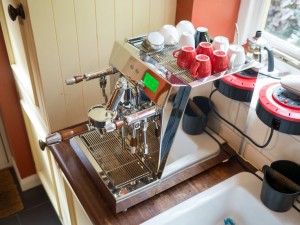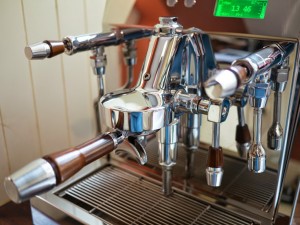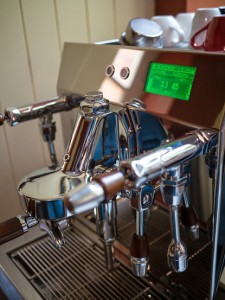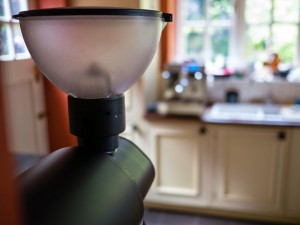Me and my Vesuvius – One week (and a bit) in
I’ve been the proud owner of an Ambient Espresso Vesuvius Pressure Profiling Coffee Machine for a little over a week now and thought it was about time for an update. I’ll try and keep things concise (probably won’t happen) and split it down into sections to keep things relevant (unlikely to happen).
In the cup
So, all other things aside this is where I was hoping that the machine would deliver and after a bumpy start I can assure you that it certainly does. When I first started to play with the machine there was no control or logic, I went at it like a bull in a china shop and mashed away at the screen without really understanding what I was doing, needless to say I managed to make some pretty bad coffee…. With this in mind I decided to restrict myself to a limited number of simple profiles until I’m fully confident with what the machine can deliver under relatively normal operating conditions. I have my main profile which attempts to emulate a NS T3 Aurelia and one that is a simple 9bar with flat pre-infusion.
The Vesuvius is paired with my EK43 Coffee and so far with this setup the results are stunning. I’m currently running 21g in 20g VST into around 40-50g which is split into two regular(ish) shots and doing so in 30-35 seconds. I mainly head towards medium/light roasts and feel like I’m in the minority of Vesuvius owners who mostly seem to prefer darker roast profiles. With my current Has Bean Blend (firmly medium) I’m getting a creaminess and sweetness that I’ve never got in espresso before. If I close my eyes then I swear that the shots had a small dash of milk and sugar in them, it’s quite ridiculous. There is muted red fruit acidity on the finish that rounds off the cup just beautifully. I’m sure that any lover of dark roasts would appreciate this for sure (this premise will be put to the test tomorrow!)
Conclusion – this machine enables me to make the best espresso that I’ve ever been able to produce at home and I’m not consistently producing shots that better my local coffee shots, which kind of makes me sad as I’ve got to find other things to do at the weekend now.
Getting Started – Hardware
After setting the machine up on the counter the first task was to fill the water tank. The opening side panel makes this task a breeze and means that the top can be used as a cup warmer without having to shift everything off to refill. Great feature! After filling I powered her up. The PID fired up and the heating element indicators lit up as expected. I ran a small amount of water through the group to ensure that the system was full. The water comes up to temperature really quickly (5 mins) and the group is nice and hot in around 20 mins which is really quick compared to my old Verona. That was pretty much it from a setup perspective.
Getting Started – PID Setup
On the whole getting started with programming this machine is pretty easy. Since there were a number of changes made since the final prototype model the production machine is currently lacking Dave Corbey’s magic PID settings. Luckily Ron got his machine a couple of weeks before me and managed to iron out most of the settings required to fully optimise the machine before mine was even built. Since then a couple of minor setting changes have been recommended by Dave and I personally feel that the machine is now pretty much bang on! I have to say that having Dave’s input has really made tweaking the machine to my tastes an absolute pleasure. Some examples of settings that required minor modifications were PID Offset, Brew PID sensitivity and Pump Sensitivity. All changes were very easily made using the touch screen and the logical menu system and the pump and temperature stability or both fantastic.
Profiles
Programming is nice and simple from the touch screen and the 7 steps give the ability to make pretty detailed profiles for sure. It would have been nice to set the pressure ramp time at each stage and I feel that this is the only current limitation within the profiling section of the machine. What I mean by this is that if I wanted the pressure to ramp slowly from 0 – 9bar over the first 10 seconds of the profile then I’d currently have to use a bunch of stages and to set the pressure increasingly higher on each one manually i.e. 2,4,6,8,9bar etc.. as the pump acceleration is a global option. It would certainly have been nice to say Stage 1, 10 seconds, 9 bar, ramp time 10 seconds and have the pid do this automatically. It’s a small thing but in my opinion would give the user maximum options and would allow for the smooth transition between pressures rather than the current stepped approach. All things considered this is a minor niggle and I’ve not managed to find a profile that I can’t emulate closely enough to make it work.
I currently use 2 main profiles as discussed earlier and I have a whole spreadsheet that contains other people’s profiles that I’ve collected from various places on the web. Once I’m totally happy with the standard operations I’ll move on to try some of these and should have a good understanding of how they change the flavour/texture of the coffee. I did indulge in a quick shot from my L1 profile earlier this evening and the results were pretty stellar, slightly more body and more red fruit than with my T3 profile. I just want to make sure I’m ready before letting myself loose again.
Conclusion – I really love the options that profiling gives me and the fact that its programmable gives me total repeatability which I feel is essential. Only time will tell how effective it is at making better tasting espresso but with the tests so far I’m confident that it will be very effective.
Steaming / Hot Water
I’m not really a milk drinker so I’ll keep this section short and sweet. I love the toggle valves, they are much better than big twiddley knobs. The steam wand isn’t the best shape for bigger jugs (ooohh matron!) and this will hopefully be rectified soon. The steaming performance is certainly more controlled than my Verona ever was and in the hands of someone who knows what they’re doing produces superb microfoam in a decent time scale. For me the Verona was too quick but this machine actually gives me time to work out what I’m doing without re-decorating my kitchen.
Conclusion – Steam wand aside, big thumbs up here!
Fit and Finish
So as soon as I got wind that the machines had landed at Bella Barista I jumped in my car and sped over to collect it. I gave them a heads up and by the time I got there my machine was on the bench, at temperature ready for me to make a couple of test shots. I was really impressed with the overall look of the machine, the new handles and feet in particular. My niggles with the prototype were now all fixed most importantly the new longer drip tray. I was made up!
Due to the construction of the Vesuvius and the extra thick panels, AE were not able to get the mirror finish that I loved on my Verona but on the whole I think that the machine looks beautiful (something that I thought I’d never say about it). I raised a few questions about some small niggles regarding the side panel and drip tray being a bit stiff to open/remove however after living with the machine for a while it’s clear to see that these are designed to be as they are for a reason. The side panel has a device that lets you open it up as far as you want it to without it just falling open onto the counter. This is really useful when refilling. The drip tray, I found, was catching on the feet as I was putting it back on wonky and the tight fit stops it vibrating around. While we’re talking vibrations, this machine doesn’t have any, even my Verona with its pretty quiet rotary pump used to vibrate most of the time, this doesn’t at all. I did have to add some small sticky dots just to keep the cup rack and drip tray rack firmly in place and to stop them sliding around, I do feel that these could have been fixed as part of the design without much effort/cost, hey ho.
I did initially have a problem with the stock shower screen as it seems to be a little deep than those on previous machines that I’ve owned. This resulted in having to under dose a VST basket by around 2g to get the correct headspace on the puck. If you dosed 18g in the 18g VST then the tamped puck was on the shower screen when locked in a 6 o clock. What this meant was that the puck was unable to expand leading to channelling and ultimately bad coffee. I swapped the screen out for an IMS that I had lying around (as you do) and hey presto! 18g in 18g VST and the perfect headspace, tasty coffee. After checking the screen it was clear that its convex shape added extra depth to it over a standard flatter version that I’ve used previously. Again not a biggie and the stock screen seems to work perfectly for other users.
The steam wand is located on the left hand side of the machine which as a righty, seems the wrong way around. As I said, I’m not really a milk drinker but I feel like I would naturally hold the jug in my strongest hand when steaming to ensure the most control. AE have advised that this could be swapped over with minimal messing but I’ll probably leave it for now as it doesn’t really affect me too much.
One other feature I love is the E61 exhaust. On the Verona the exhaust was raised up from the drip tray which meant that keeping scales on the drip tray was a pain due to how easy it was to fill them with water inadvertently. The exhaust on the Vesuvius is flush with the drip tray which means that my scales are safe and can be kept there all the time, big thumbs up!
Conclusion – A few minor gripes aside this thing feels solid as a rock. Any downsides listed here are vastly offset by the taste of my coffee over the last few days!
Other
There are a couple of other small things that really make using this machine a pleasure.
Last shot protection – ensures that the machine never cuts the pump part way through a shot to ask you to refill, bloody great idea!
Power saving/Auto off mode – gives you the ability to set a timer that if the machine is not used by then it drop the temp down to one which you can calibrate. The machine then springs back to life at the flick of the lever and warm-up times are much faster from this state. An example would be after 60 minutes without use drop the brew boiler temp down to 50deg. You can also program it so that after say 3 hours with no use that the machine powers off completely.
Week on/off timer – You can set the machine to automatically power on and off each day of the week so you can say Monday/Thursday power up and 6:30 am, off and 9am, on at 16:30 and off at 7pm. Friday power on 7am, off at 09:30, on at 16:00 and off at 8pm. Saturday on a 8am off at 8pm, Sunday off all day. Etc…
Anyway, my brain hurts from writing so many words and I hope that you found at least some of my ramblings interesting. I’m quite sure that I’ve missed loads of important info off and will update if it ever springs to mind. I’ll leave you now with a few pics for those who agree that a picture speaks 1000 words.







11 Comments. Leave new
Excellent review buddy! I have just placed an order for the Vesuvius after reading your take.on the machine! How have you been getting on with it for the last year, any new observation on the hardware or software?!
Hey Chris,
It’s still the best non-commercial machine I’ve ever used, I love it! I find that I’m not going crazy with the pressure, in fact I’m running a pretty simple profile these days. I go 3.4bar for 8 seconds and then the rest of the shot at 7bar. I use an EK43 which is quite sensitive to pressure. I find the the Vesuvius allows me to get the best out of my coffee with my setup and can’t think of a machine that I would swap it for today.
I would have loved to see some extra tweaks in the profiles and other settings but no deal breakers and as it’s impossible to add features to the machine as it stands then I’m not losing any sleep over it.
Spence
We just got ours. A question: how do you attach the feet to the machine?
Good question…. Bella Barista actually fitted mine for me in store.
Pretty sure that the owner’s guide had instruction, no?
Have you had any service issues since you purchased your machine?
Hi Tony,
Not really, there were a couple of known issues with the first models that were resolved but other than that it worked well. I’ve since sold the machine so can’t comment for the last year or so.
Cheers
Spence
Great review. i’m currently checking tons of review and battling between vesuvius and londinium. As you mentioned you have sold the machine, what was the reason and what you decided to get to replace it?
Hi there,
For me the Vesuvius was a great experiment. I enjoyed it greatly. However, I felt like it lacked some features that were a must for me so I moved it on and replaced it with a sage dual boiler. The main downsides of the Vesuvius were heat up time, temperature stability when running reduced flow rates, lack of ability to move stages manually. These are not deal breakers for some but for me they were a must. I’ve just taken delivery of a Decent DE1 which I’m finding much more satisfactory 🙂
Hi Spence,
Very good review. I wonder what was the reason for selling the vesuvius? Have you got another maschine and if so which one?
Sage Dual Boiler, same as the brevelle dual boiler, I most recently upgraded to a decent DE1.